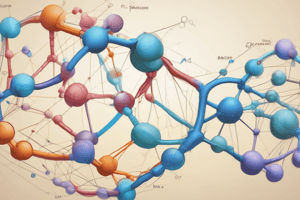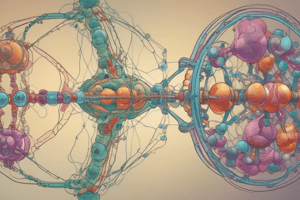Podcast
Questions and Answers
Which enzyme is responsible for converting ribose-5-phosphate to phosphoribosylpyrophosphate in De Novo Purine Synthesis?
Which enzyme is responsible for converting ribose-5-phosphate to phosphoribosylpyrophosphate in De Novo Purine Synthesis?
- Glutamine phosphoribosylpyrophosphate amidotransferase
- PRPP synthetase (correct)
- Hypoxanthine-guanine phosphoribosyltransferase
- Adenine phosphoribosyltransferase
What is the primary function of the Purine Salvage Pathway?
What is the primary function of the Purine Salvage Pathway?
- To regulate energy metabolism in muscle tissue
- To convert hypoxanthine to xanthine and xanthine to uric acid
- To synthesize inosine monophosphate from ribose-5-phosphate and amino acids
- To recycle purine bases and nucleosides to form nucleotides (correct)
What is the role of adenosine in the body?
What is the role of adenosine in the body?
- An enzyme involved in De Novo Purine Synthesis
- A signaling molecule involved in sleep, pain, and inflammation (correct)
- A molecule involved in regulating energy metabolism
- A precursor to inosine monophosphate
What is the function of xanthine oxidase?
What is the function of xanthine oxidase?
What is the primary function of the Purine Nucleotide Cycle?
What is the primary function of the Purine Nucleotide Cycle?
Which enzyme is involved in the conversion of IMP to AMP in the Purine Nucleotide Cycle?
Which enzyme is involved in the conversion of IMP to AMP in the Purine Nucleotide Cycle?
Study Notes
De Novo Purine Synthesis
- Occurs in the liver, kidneys, and other tissues
- Synthesizes inosine monophosphate (IMP) from ribose-5-phosphate and amino acids
- IMP is the precursor to adenosine and guanosine nucleotides
- Enzymes involved:
- PRPP synthetase (converts ribose-5-phosphate to phosphoribosylpyrophosphate)
- Glutamine phosphoribosylpyrophosphate amidotransferase (converts phosphoribosylpyrophosphate to IMP)
Purine Salvage Pathway
- Recycles purine bases and nucleosides to form nucleotides
- Enzymes involved:
- Adenine phosphoribosyltransferase (converts adenine to AMP)
- Hypoxanthine-guanine phosphoribosyltransferase (converts hypoxanthine and guanine to IMP and GMP)
- Occurs in the liver, kidneys, and other tissues
- Important for maintaining purine nucleotide levels and preventing uric acid accumulation
Adenosine Metabolism
- Adenosine is a signaling molecule involved in sleep, pain, and inflammation
- Metabolized by adenosine deaminase to inosine
- Adenosine receptors (A1, A2A, A2B, A3) mediate its effects on the body
- Adenosine is a vasodilator and has anti-inflammatory properties
Xanthine Oxidase Function
- Converts hypoxanthine to xanthine and xanthine to uric acid
- Found in the liver, kidneys, and small intestine
- Inhibitors of xanthine oxidase (e.g., allopurinol) are used to treat gout and hyperuricemia
- Xanthine oxidase also generates reactive oxygen species (ROS), contributing to oxidative stress
Purine Nucleotide Cycle
- A metabolic pathway that interconverts AMP, IMP, and GMP
- Involved in regulating energy metabolism, particularly in muscle tissue
- Enzymes involved:
- Adenylate kinase (converts AMP to ADP)
- Adenylosuccinate synthase (converts IMP to AMP)
- GMP synthase (converts IMP to GMP)
- Plays a role in maintaining energy homeostasis and regulating muscle contraction
Studying That Suits You
Use AI to generate personalized quizzes and flashcards to suit your learning preferences.
Description
Understand the de novo purine synthesis process and the purine salvage pathway, including the enzymes involved and the synthesis of inosine monophosphate (IMP).




